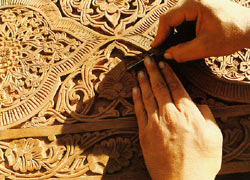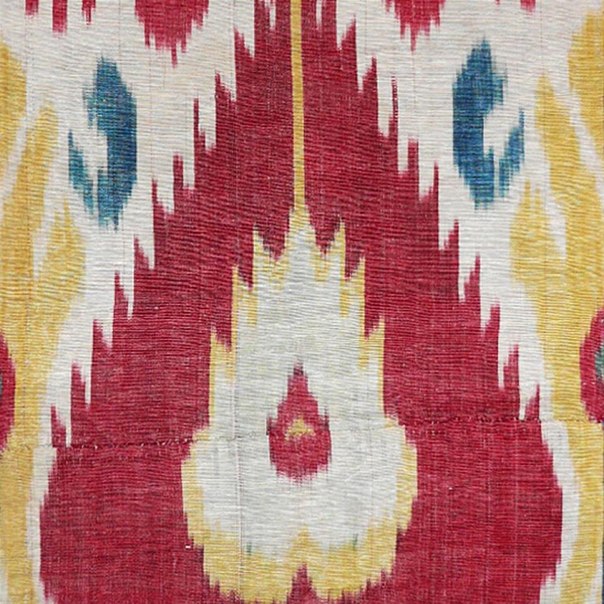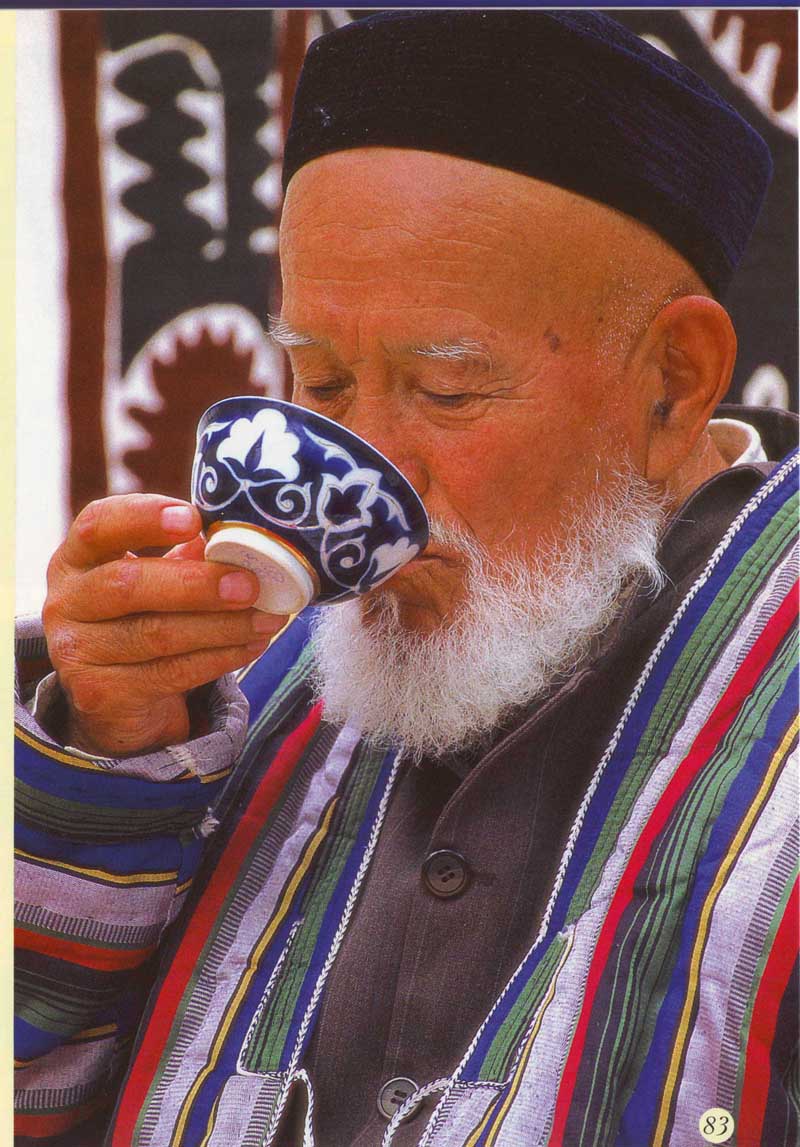-
Khiva, main gates Ota Darvaza
-
Khiva
-
Bukhara, Nodir Divan-Begi madrassah
-
Bukhara, Ark Fortress
-
Tashkent, Khast Imam Square
-
Bukhara
-
Samarkand, ensemble Shakhi Zinda
-
Bukhara, view on to Miri-Arab madrassah, XVI c.
-
Kyzylkum desert, riding on camels
-
Konigil village, silk paper center, noria
-
Sherdor madrassah, Samarkand
-
Samarkand, Registan Square
Main / Uzbekistan /
Culture - Soul Of People
To get an idea of the history and culture of the country, you can visit its museums. In Uzbekistan, there are now more than a hundred museums. Very large number of them is located in Tashkent. It is, first of all, Amir Temur Museum, the Museum of History of Uzbekistan, State Museum of Art, the Museum of Applied Arts and dozens of others. Interesting are museums of ancient Uzbek cities of Samarkand, Bukhara, Khiva, Termez. One of the most famous museums of Uzbekistan, and, perhaps, the whole of Central Asia - Museum of Arts named after Savitsky is located in the capital of the Republic of Karakalpakstan, Nukus.
Uzbekistan is famous in the world not only for its museums, architectural monuments of the ancient cities, but also for prominent scientists, educators and poets - Al Khwarizmi, Ibn Sina (Avicenna), Alisher Navoi, Omar Khayyam, Ulugbek. The production of applied arts of Uzbek skilled craftsmen are known all over the world. Many museums keep amazingly beautiful engraved products, jewelry, weapons, medieval miniatures created by the masters of our ancient land.
Modern Uzbekistan is very careful towards the traditional cultural values, with the support of the state people revive and develop dozens of ancient crafts. So was revived, for example, an old Rishtan ceramics with blue frosting, which enjoyed an unusually high demand all over the Great Silk Road. In the XX century, it was almost completely gone, unable to compete with cheap factory dishes, as well as other centers of ceramics in Samarkand, Bukhara, Khiva, Gijduvan also now restored.
Today, the colorful bazaars of towns and cities of Uzbekistan are full of handmade pottery - all kinds of dishes, small plastic products and toys; and each region has its own unique style.
 Here carvers offer elaborately carved boxes, pencil boxes, tables and chairs, screens, window bars, chandeliers, doors and pillars, amazing laukhs. Laukh is folding in several levels book holder, made from one piece of wood without a single attachment. Miniaturists exhibit different sizes and shapes of boxes of wood and papier-mache, covered with delicate ornamental paintings and miniatures. Weavers demonstrate their amazing beauty products, continuing the tradition of their ancestors. Since ancient times Bukhara and Khiva carpets have been famous all over the world. Jewellers offer dozens, if not hundreds of ornaments. And who knows, maybe, Bukhara women wore a thousand years ago the same jewelry, which can be seen today, for example, under the trade dome Tak-i-Zargaron in Bukhara...
Here carvers offer elaborately carved boxes, pencil boxes, tables and chairs, screens, window bars, chandeliers, doors and pillars, amazing laukhs. Laukh is folding in several levels book holder, made from one piece of wood without a single attachment. Miniaturists exhibit different sizes and shapes of boxes of wood and papier-mache, covered with delicate ornamental paintings and miniatures. Weavers demonstrate their amazing beauty products, continuing the tradition of their ancestors. Since ancient times Bukhara and Khiva carpets have been famous all over the world. Jewellers offer dozens, if not hundreds of ornaments. And who knows, maybe, Bukhara women wore a thousand years ago the same jewelry, which can be seen today, for example, under the trade dome Tak-i-Zargaron in Bukhara...
In all ages, artisans of the area between the rivers Amu Darya and Syr Darya, Ferghana valley were famous for their mastery of metal working. And how else, as the local mountains from time immemorial, were full of gold, silver, copper, iron and tin. According to Arab historian of the X century Ibn Haukal "iron weapons from Ferghana was in general use from Khorasan to Baghdad." Some researchers argue that the birthplace of Damascus steel was Ferghana. Europeans just saw this steel in Damascus, where it came from Central Asia along the Silk Road.
Arab geographer and traveler of the X century, Al-Muqaddasi, telling about the goods exported from the Samanid state, mentions precious silverware and brass lamps from Bukhara, intricately carved and decorated with Arabic inscriptions. Modern engravers on metal manufacture products of the same amazing beauty as masters of the Samanid or Timurid epoch, and that's were periods of unprecedented flowering of culture and the arts.
 In recent years, Uzbek abr fabrics are in great demand in many countries. Pattern "abr" - "cloud" is one of the oldest and most beloved in Uzbekistan. The secret of its manufacture is that threads are dyed and not the ready fabrics.
In recent years, Uzbek abr fabrics are in great demand in many countries. Pattern "abr" - "cloud" is one of the oldest and most beloved in Uzbekistan. The secret of its manufacture is that threads are dyed and not the ready fabrics.
Coils of threads of silk, wool, cotton, before diving into the staining solution, are tied in the special way. The result is a bright shimmering with iridescent paints silk khan-atlas, semi-silk fabric called adras, fabric shoyi. Elegant striped gown is produced by a traditional technology.
In Uzbekistan, there are dozens of crafts such as embroidery, famous Bukhara gold embroidery, painting on skin, pumpkin carving on alabaster and stone, production of dolls, puppets and musical instruments, boxes and cradles for babies - beshik ... All of crafts can be found right in the workshops located in the bazaars, in the old madrassahs, in the streets of ancient cities.
.jpg) However the most vivid picture of Uzbekistan is available during the holidays and folk festivals, for example, during the celebration of Navruz, when the streets and squares of towns and cities face numerous folk groups in traditional costumes, and costumes of each region may be very different from each other . During these festivals everywhere you will hear traditional music and songs, you can see the hot dances, folk games, contests, singers and strong men (palvans), cock and ram fights, tightrope walkers and puppeteers performances and, of course, theatrical performances at the legendary stories on everyday topics, telling about national traditions and customs. Perhaps that is why Uzbekistan citizens love theater, theatres so much. There are theatres in every city, a total of 35 professional theatres in the country - drama, music, puppetry, opera (in Tashkent and Samarkand), and many amateur ones.
However the most vivid picture of Uzbekistan is available during the holidays and folk festivals, for example, during the celebration of Navruz, when the streets and squares of towns and cities face numerous folk groups in traditional costumes, and costumes of each region may be very different from each other . During these festivals everywhere you will hear traditional music and songs, you can see the hot dances, folk games, contests, singers and strong men (palvans), cock and ram fights, tightrope walkers and puppeteers performances and, of course, theatrical performances at the legendary stories on everyday topics, telling about national traditions and customs. Perhaps that is why Uzbekistan citizens love theater, theatres so much. There are theatres in every city, a total of 35 professional theatres in the country - drama, music, puppetry, opera (in Tashkent and Samarkand), and many amateur ones.
Uzbekistan is famous in the world not only for its museums, architectural monuments of the ancient cities, but also for prominent scientists, educators and poets - Al Khwarizmi, Ibn Sina (Avicenna), Alisher Navoi, Omar Khayyam, Ulugbek. The production of applied arts of Uzbek skilled craftsmen are known all over the world. Many museums keep amazingly beautiful engraved products, jewelry, weapons, medieval miniatures created by the masters of our ancient land.
Modern Uzbekistan is very careful towards the traditional cultural values, with the support of the state people revive and develop dozens of ancient crafts. So was revived, for example, an old Rishtan ceramics with blue frosting, which enjoyed an unusually high demand all over the Great Silk Road. In the XX century, it was almost completely gone, unable to compete with cheap factory dishes, as well as other centers of ceramics in Samarkand, Bukhara, Khiva, Gijduvan also now restored.
Today, the colorful bazaars of towns and cities of Uzbekistan are full of handmade pottery - all kinds of dishes, small plastic products and toys; and each region has its own unique style.
 Here carvers offer elaborately carved boxes, pencil boxes, tables and chairs, screens, window bars, chandeliers, doors and pillars, amazing laukhs. Laukh is folding in several levels book holder, made from one piece of wood without a single attachment. Miniaturists exhibit different sizes and shapes of boxes of wood and papier-mache, covered with delicate ornamental paintings and miniatures. Weavers demonstrate their amazing beauty products, continuing the tradition of their ancestors. Since ancient times Bukhara and Khiva carpets have been famous all over the world. Jewellers offer dozens, if not hundreds of ornaments. And who knows, maybe, Bukhara women wore a thousand years ago the same jewelry, which can be seen today, for example, under the trade dome Tak-i-Zargaron in Bukhara...
Here carvers offer elaborately carved boxes, pencil boxes, tables and chairs, screens, window bars, chandeliers, doors and pillars, amazing laukhs. Laukh is folding in several levels book holder, made from one piece of wood without a single attachment. Miniaturists exhibit different sizes and shapes of boxes of wood and papier-mache, covered with delicate ornamental paintings and miniatures. Weavers demonstrate their amazing beauty products, continuing the tradition of their ancestors. Since ancient times Bukhara and Khiva carpets have been famous all over the world. Jewellers offer dozens, if not hundreds of ornaments. And who knows, maybe, Bukhara women wore a thousand years ago the same jewelry, which can be seen today, for example, under the trade dome Tak-i-Zargaron in Bukhara...In all ages, artisans of the area between the rivers Amu Darya and Syr Darya, Ferghana valley were famous for their mastery of metal working. And how else, as the local mountains from time immemorial, were full of gold, silver, copper, iron and tin. According to Arab historian of the X century Ibn Haukal "iron weapons from Ferghana was in general use from Khorasan to Baghdad." Some researchers argue that the birthplace of Damascus steel was Ferghana. Europeans just saw this steel in Damascus, where it came from Central Asia along the Silk Road.
Arab geographer and traveler of the X century, Al-Muqaddasi, telling about the goods exported from the Samanid state, mentions precious silverware and brass lamps from Bukhara, intricately carved and decorated with Arabic inscriptions. Modern engravers on metal manufacture products of the same amazing beauty as masters of the Samanid or Timurid epoch, and that's were periods of unprecedented flowering of culture and the arts.
 In recent years, Uzbek abr fabrics are in great demand in many countries. Pattern "abr" - "cloud" is one of the oldest and most beloved in Uzbekistan. The secret of its manufacture is that threads are dyed and not the ready fabrics.
In recent years, Uzbek abr fabrics are in great demand in many countries. Pattern "abr" - "cloud" is one of the oldest and most beloved in Uzbekistan. The secret of its manufacture is that threads are dyed and not the ready fabrics.Coils of threads of silk, wool, cotton, before diving into the staining solution, are tied in the special way. The result is a bright shimmering with iridescent paints silk khan-atlas, semi-silk fabric called adras, fabric shoyi. Elegant striped gown is produced by a traditional technology.
In Uzbekistan, there are dozens of crafts such as embroidery, famous Bukhara gold embroidery, painting on skin, pumpkin carving on alabaster and stone, production of dolls, puppets and musical instruments, boxes and cradles for babies - beshik ... All of crafts can be found right in the workshops located in the bazaars, in the old madrassahs, in the streets of ancient cities.
.jpg) However the most vivid picture of Uzbekistan is available during the holidays and folk festivals, for example, during the celebration of Navruz, when the streets and squares of towns and cities face numerous folk groups in traditional costumes, and costumes of each region may be very different from each other . During these festivals everywhere you will hear traditional music and songs, you can see the hot dances, folk games, contests, singers and strong men (palvans), cock and ram fights, tightrope walkers and puppeteers performances and, of course, theatrical performances at the legendary stories on everyday topics, telling about national traditions and customs. Perhaps that is why Uzbekistan citizens love theater, theatres so much. There are theatres in every city, a total of 35 professional theatres in the country - drama, music, puppetry, opera (in Tashkent and Samarkand), and many amateur ones.
However the most vivid picture of Uzbekistan is available during the holidays and folk festivals, for example, during the celebration of Navruz, when the streets and squares of towns and cities face numerous folk groups in traditional costumes, and costumes of each region may be very different from each other . During these festivals everywhere you will hear traditional music and songs, you can see the hot dances, folk games, contests, singers and strong men (palvans), cock and ram fights, tightrope walkers and puppeteers performances and, of course, theatrical performances at the legendary stories on everyday topics, telling about national traditions and customs. Perhaps that is why Uzbekistan citizens love theater, theatres so much. There are theatres in every city, a total of 35 professional theatres in the country - drama, music, puppetry, opera (in Tashkent and Samarkand), and many amateur ones.
Review 

Buenos dias:
Os escribo solo para deciros que los clientes han venido a decirme que el viaje ha estado perfecto, sobre todo el guнa, que fue muy atento con ellos en ...
all reviews
all reviews














